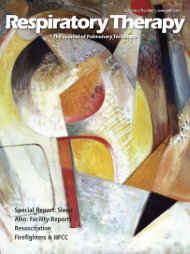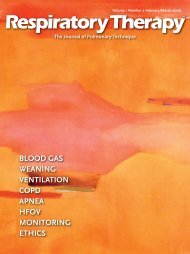RT 02-03 JJ07 main web - Respiratory Therapy Website
RT 02-03 JJ07 main web - Respiratory Therapy Website
RT 02-03 JJ07 main web - Respiratory Therapy Website
Create successful ePaper yourself
Turn your PDF publications into a flip-book with our unique Google optimized e-Paper software.
Closed-loop control ventilation could make this method<br />
available to us today. Through employing closed-loop control<br />
ventilation, minute ventilation can be <strong>main</strong>tained while tidal<br />
volume and rate are varied. Current research is investigating<br />
what “variability index” or coefficient of variation is optimal to<br />
program into the ventilatory pattern. If variance of tidal volume<br />
can add to the benefit of the already employed lung protective<br />
strategies, then perhaps closed-loop control additionally<br />
employing ‘variation’ will be of benefit.<br />
Sources<br />
Arold SP, Suki B, Alencar AM, Lutchen KR, and Ingenito EP.<br />
Variable ventilation induces endogenous surfactant release<br />
in normal guinea pigs. Am J Physiol Lung Cell Mol Physiol<br />
285: L370-L375, 20<strong>03</strong>.<br />
Arold SP, Mora R, Lutchen KR, Ingenito EP, and Suki B. Variable<br />
tidal volume ventilation improves lung mechanics and gas<br />
exchange in a rodent model of acute lung injury. Am J Respir<br />
Crit Care Med 165: 366- 371, 20<strong>02</strong>.<br />
Boker A, Graham MR, Walley KR, McManus BM, Girling LG,<br />
Walker E, Lefevre GR, and Mutch WA. Improved arterial<br />
oxygenation with biologically variable or fractal ventilation<br />
using low tidal volumes in a porcine model of acute<br />
respiratory distress syndrome. Am J Respir Crit Care Med<br />
165: 456-462, 20<strong>02</strong>.<br />
Faridy EE, Permutt S, and Riley RL. Effect of ventilation on<br />
surface forces in excised dogs’ lungs. J Appl Physiol 21:<br />
1453-1462, 1966.<br />
Oyarzun MJ, Clements JA, and Baritussio A. Ventilation<br />
enhances pulmonary alveolar clearance of radioactive<br />
dipalmitoyl phosphatidylcholine in liposomes. Am Rev<br />
Respir Dis 121: 709-721, 1980.<br />
Post M and van Golde LM. Metabolic and developmental aspects<br />
of the pulmonary surfactant system. Biochim Biophys Acta<br />
947:249-286, 1988.<br />
Suki B, Alencar AM, Sujeer MK, Lutchen KR, Collins JJ, Andrade<br />
JS Jr, Ingenito EP, Zapperi S, and Stanley HE. Life-support<br />
system benefits from noise. Nature 393: 127-128, 1998.<br />
Wirtz HR and Dobbs LG. Calcium mobilization and exocytosis<br />
after one mechanical stretch of lung epithelial cells. Science<br />
250: 1266-1269, 1990.<br />
Intelligent Ventilation In<br />
A Critically Ill Child<br />
Melissa Turner, BA, R<strong>RT</strong><br />
Reprinted from Hamilton Medical’s Ventilation Newsletter.<br />
Mechanical ventilation is a necessary evil for the critically ill<br />
child. On the one hand, it is essential to saving lives. On the<br />
other hand, it can contribute to muscle weakness, pulmonary<br />
injury, and a greater mortality. According to Wratney and<br />
Dalton, “extubation failure is common (5 percent to 27 percent)<br />
and is independently associated with a fivefold increased risk of<br />
mortality.” A child who must undergo intubation and mechanical<br />
ventilation requires careful watch and diligent care. To date,<br />
there are no set practices for weaning and extubation in the<br />
pediatric population, therefore the practices are variable.<br />
Wratney and Dalton inform us that the mortality rate for inhospital<br />
pediatric patients with extubation failure is 46% as<br />
compared with in-hospital pediatric patients with successful<br />
extubation being 6.3%. “Extubation delay, or the failure to<br />
recognize the capacity for spontaneous breathing and airway<br />
control, is of significant concern in the pediatric population.”<br />
Readiness for extubation is a target that is commonly missed in<br />
this patient population. “Data have shown 63% of patients who<br />
self-extubate are able to re<strong>main</strong> successfully extubated, which<br />
may indicate patient readiness for ventilator discontinuation<br />
prior to this fact being recognized by the medical team.” With<br />
Intelligent Ventilation, readiness to wean to extubation may be<br />
identified as it occurs. Once the patient is able to breathe<br />
spontaneously, Intelligent Ventilation will allow them to do so<br />
while continuing to support the patient. Support is<br />
automatically withdrawn as the patient is able to <strong>main</strong>tain<br />
adequate ventilation on their own. If the patient is unable to<br />
<strong>main</strong>tain ventilation at any point in time, Intelligent Ventilation<br />
takes control to be sure the patient <strong>main</strong>tains a breathing<br />
pattern that is sufficient and imposes the least work of<br />
breathing. Since the patient is allowed to take over the control<br />
of breathing as their respiratory drive, strength and mechanics<br />
improve, weaning can begin at the point of patient readiness<br />
without waiting for human intervention as we do when we<br />
change from a controlled mode to SIMV to spontaneous modes.<br />
It has been shown that the “mode of ventilation used during the<br />
weaning period has no effect on ventilator length of stay or<br />
extubation success.” With Intelligent Ventilation the patient is<br />
able to switch between controlled and spontaneous ventilation<br />
as needed and as appropriate which takes the guesswork out of<br />
when to change modes and begin weaning. The whole process<br />
becomes automated and provides safe guards not available with<br />
traditional spontaneous breathing trials (t-piece or pressure<br />
support trials). As indicated by Wratney and Dalton, the<br />
following factors should be taken to consideration by the<br />
clinician as influential in successful weaning. Each of the<br />
following must be optimized for proper assessment:<br />
• patient-ventilator synchrony via sensitive and responsive<br />
ventilator-triggering systs<br />
• triggering threshold for the patient that optimizes<br />
spontaneous breathing<br />
• ventilator cycling from inspiration to expiration to avoid<br />
airtrapping measuring the effective delivered tidal volume at<br />
the endotracheal tube. To effectively measure delivered tidal<br />
volume, a pneumotach should be placed at the endotracheal<br />
tube. This feature is available on some ventilators.<br />
• assessment of residual sedative effect and/or sedative<br />
withdrawal on ventilatory drive, patient comfort, and<br />
respiratory load.<br />
It is helpful to be able to measure the WOB, PO, and RSB in<br />
select patients. Automatic tube resistance compensation (TRC)<br />
may be useful as it more accurately proportions pressure<br />
support to overcome imposed resistive load caused by the<br />
endotracheal tube.<br />
Intelligent Ventilation or Intelligent Ventilators are now available<br />
and can facilitate these optimization goals. These closed loop<br />
control systems represent a new era in mechanical ventilation.<br />
Hamilton Medical’s Adaptive Support Ventilation Intelligent<br />
Ventilation System has been in clinical use for 9 years.<br />
Hamilton’s Intelligent Ventilation continuously implements a set<br />
of protective rules that optimize I:E ratio, tidal volume and rate<br />
(as a result automated determination of the ‘Optimal’ breathing<br />
pattern/least work of breathing).<br />
<strong>Respiratory</strong> <strong>Therapy</strong> Vol. 2 No. 3 � June-July 2007 19











